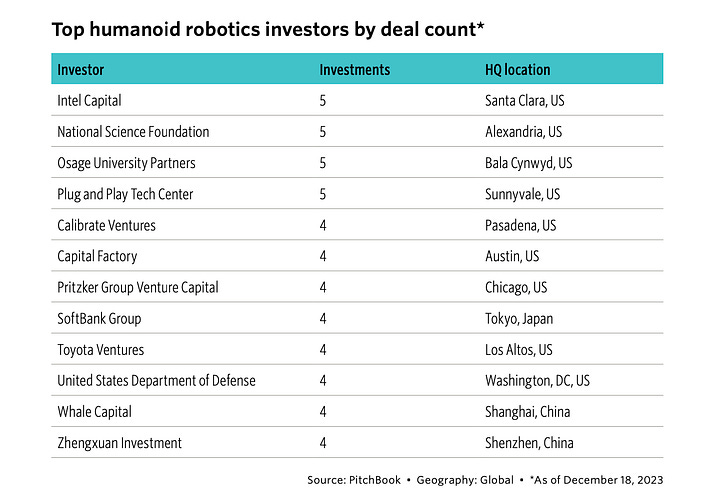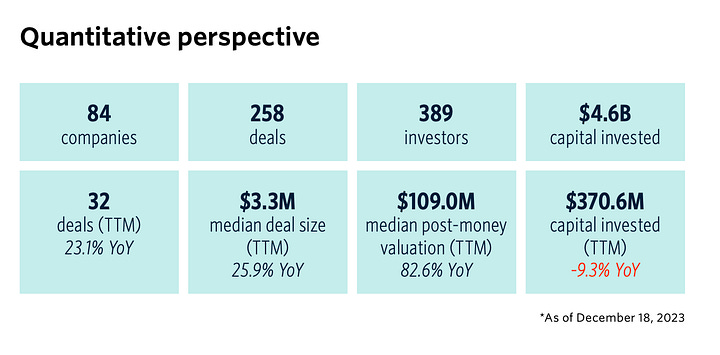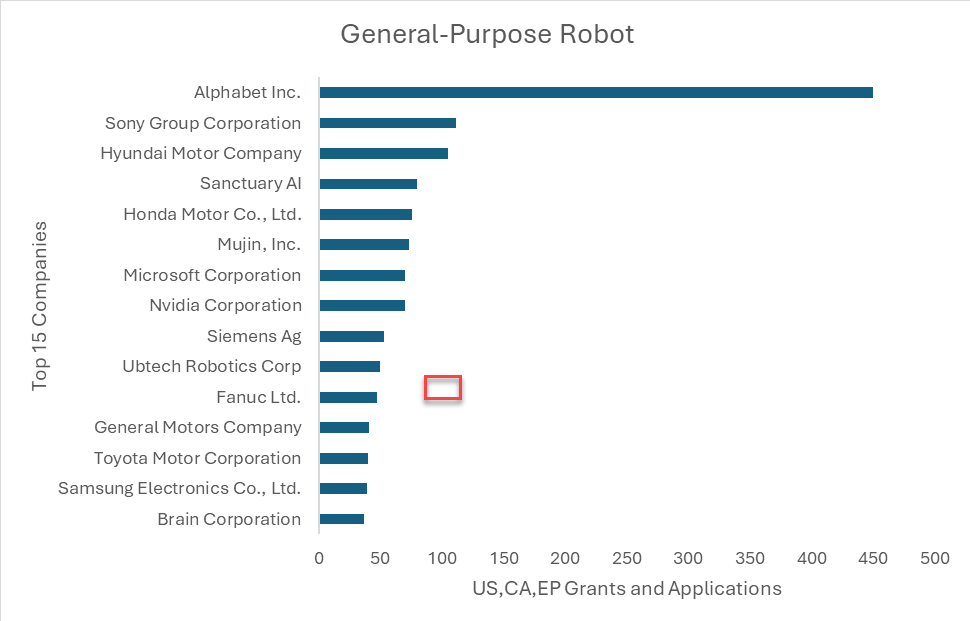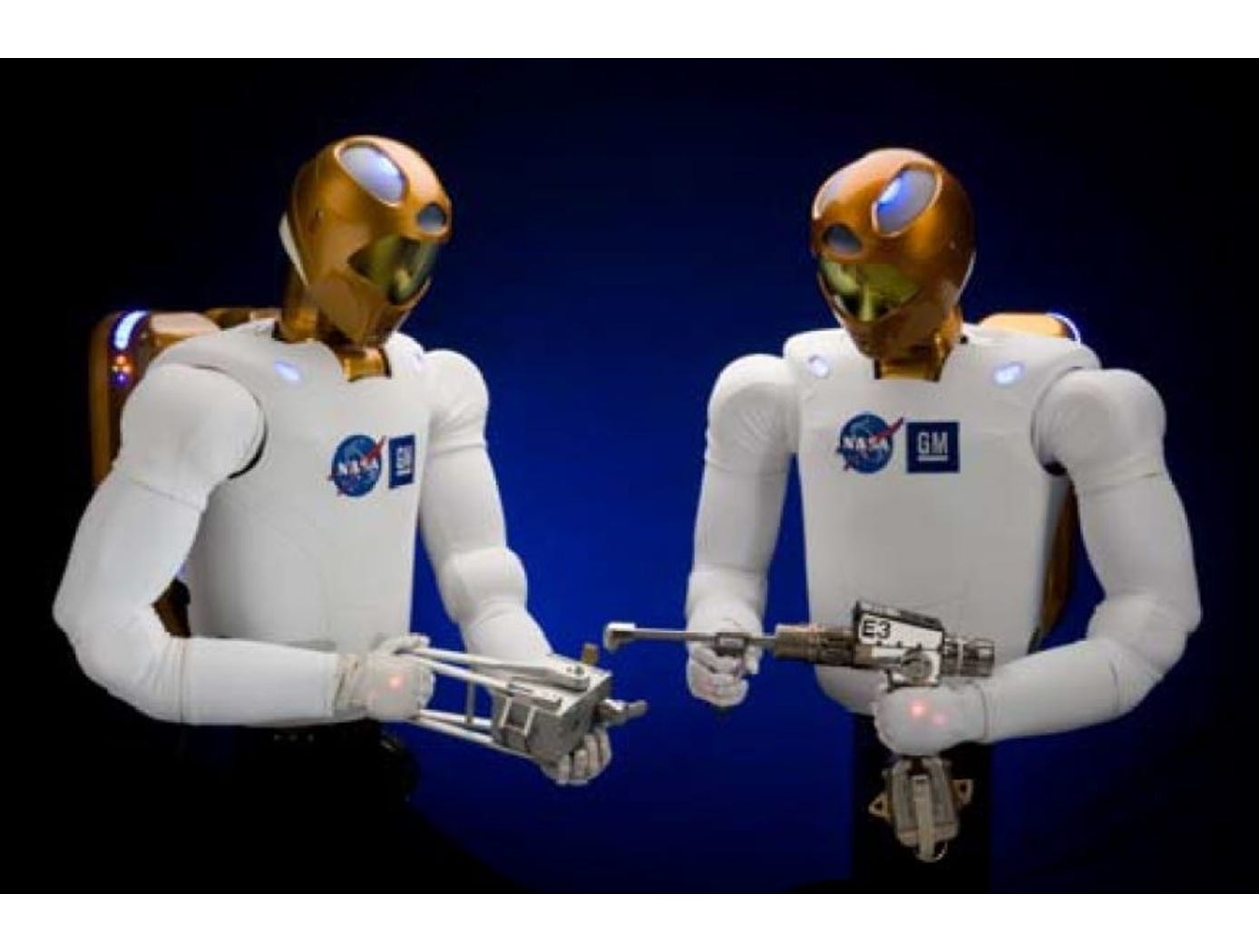Two interesting points from this report by Tech+IP and Own Innovation:
Sanctuary AI is in the Patent game and what’s less obvious is that GM is also - via partnership with NASA. The NASA patents are all available for licensing.
See below for more information about both.
Using patent classification methods and sematic techniques in a recursive process to run, test, identify and improve search results, the Tech+IP and Own Innovation teams identified over 3,000 assets relating specifically to General Purpose Robot training features and execution capabilities and nearly 1,000 assets relating to dexterous manipulation technologies (including hardware and software). Results were then stack-ranked by the owning company in each area – we ranked the first 15 in each category in Figures 1 and 2 above, respectively.
When will the humanoid patent wars break out?
A spate of stories in the trade press and a recent Wall Street Journal op-ed, “Humanoid robots are the next threat from China” by Senator Katie Britt and Jacob Helberg highlight an urgent need for the US to take action against the rising influence of China in humanoid robotic technology.
The emphasis on the critical need for North American leadership in this sector affecting both military and many civilian industries follows 2024 reports from Goldman Sachs that recent advancements in artificial intelligence (AI), machine learning (ML) and other factors will propel the global humanoid market to 70% annual growth through 2035. It could potentially reach $154 billion by the end of 2035 in a blue-sky scenario (that would be approximately one-third of the 2021 global smartphone market).
With the deep tech involved in humanoid robotics R&D and the well-chronicled patent wars that accompanied the rise of the smartphone, we thought it timely and prudent to look at the patent situation in humanoid technology. We note that there have been reports from numerous sources about China’s “lead” in robotics patents, while others indicate a rapidly closing race.
In this article we provide data and insights into the evolving patent landscape of humanoid robots with an emphasis on North American and European granted patents and applications. Both Tech+IP and Own Innovation have been actively working with leading innovators in the humanoid robotics market for some time. We believe that this review is important both from the point of view of what it says about innovation and what it might portend from a competitive standpoint into the future.
If we are to believe Senator Britt, this kind of patent landscape is even more important due to the limited right to exclude that patents represent for the innovative companies that own them (and even in some instances government agencies such as NASA and others).
Two technologies differentiating humanoids
Although we note that publication of patent applications and patent issuances is only a partial proxy for actual innovation and potential market leadership, we think that with proper search techniques and caveats, it can still be a useful proxy, at least for directional or trend information. We anticipate various improvements in future versions of this study.
In performing this preliminary analysis, we focused on issued US, Canadian and European patents and published patent applications as of April 2024. We left out patents issued or pending in China and other jurisdictions for a host of reasons, including that assessing quality of such patents is quite difficult and as shown with smartphones and other technologies, the patent wars may involve Chinese companies, but the main battlegrounds are typically in these jurisdictions rather than inside China. Future, more refined analyses should consider additional jurisdictions (as has also occurred in smartphone and other standard essential patent licensing).
Importantly, we also note that a humanoid robot uses numerous technologies and structures in common with non-humanoid robots that have been the subject of R&D for at least 20 years and that comprise well over 100,000 patents (72,618 robotic patents being granted between 2005 and 2019 alone). Medical robotics is a substantial area of patenting activity that may show up in certain searches related to humanoid robots, we excluded medical robotics from our study.
To efficiently get to the heart of the matter, we decided to focus for the time being on two main groups of technologies that both differentiate humanoids from other kinds of robots and that in substantial part have been propelled by technological advances in applications of AI and ML (including large language model (LLM) technologies and the use of numerous technologies to propel training and adaptation as well as execution).
Technology groups in our study include:
The first group encompasses general-purpose robots (GPRs), particularly their training features and execution capabilities (Figure 1).
The second group encompasses dexterous manipulation technologies (including hardware and software) due to their importance in emulating human elements such as the human hand, thumb and fingers that work together to grasp, hold and manipulate objects of all kinds (Figure 2). The ability of the human thumb to oppose other fingers, for example, is considered a crucial evolutionary adaptation allowing development of human dexterity and complex tool use.
These developments have significantly influenced innovations in the field and thus the patent landscape, contributing to the future landscape of robotics. While we concede there are other areas of substantial importance as well (and welcome community feedback), this narrowing helped us to choose both differentiated technologies for humanoids and isolate humanoid robotics patents from other associated technologies having applications across multiple industries like automotive, manufacturing, logistics and warehousing.
Read more at Tech IP and Own Innovation
NASA and General Motors, two organizations at the forefront of robotics, have developed the Robonaut 2 (R2) a state-of-the-art, dexterous, humanoid robot capable of performing tasks in an automated fashion (or via teleoperation). The technology developed throughout the project represents the cutting edge of autonomous, humanoid robotics.
These technologies are available for licensing, both in a modular fashion or as an integrated system, to enhance your robotic products. Please see the Related Links section below for information on additional R2 robotics technologies, including those related to arms, interface/control, and sensor systems.
Related Links:
The Robonaut 2 hand - designed to do work with tools
MSC-TOPS-101: Advanced Humanoid Robotic Arm Technologies
MSC-TOPS-103: Advanced Humanoid Robotic Interface & Control
MSC-TOPS-104: Advanced Robotic Sensing Technologies
R2s hand and forearm assembly, the topic of this flyer, is designed to approximate closely the capabilities of the human hand. The assembly is a completely self-contained unit featuring high dexterity, fine force control, and advanced sensing that enables the grasping and actuation of a broad array of tools. Relocation of components (e.g., motors, avionics) to the forearm makes room for increased sensing in the fingers and palm, where it is needed most.
Read more at NASA Technology Transfer Program
Pitchbook Humanoids Report (280 company count)













